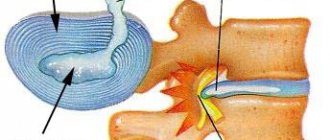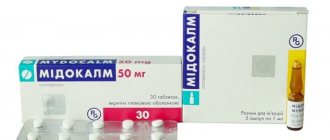The drug Mydocalm is intended for therapeutic purposes in neurology - it relieves pain syndromes, restores muscle tone, and normalizes trophism. It has a local anesthetic effect and membrane-stabilizing properties. By dilating blood vessels, it accelerates blood circulation and lymph outflow. Reduces tension in the musculoskeletal system.
Compound
International nonproprietary name of the drug (INN) Tolperisone.
One Mydocalm tablet contains 50 or 150 mg of tolperisone hydrochloride as an active substance, as well as auxiliary components:
- citric acid monohydrate (Acidum citricum monohydrate);
- colloidal silicon dioxide (Silicii dioxydum colloidale);
- stearic acid (Acidum stearicum);
- talc (Talcum);
- microcrystalline cellulose (Cellulosum microcrystallicum);
- corn starch (Amylum maidis);
- lactose monohydrate.
The film coating with which the tablets are coated contains:
- colloidal silicon dioxide (Silicii dioxydum colloidale);
- titanium dioxide (Titanium dioxide);
- lactose monohydrate;
- macrogol 6000 (Macrogol 6000);
- hypromellose (Hypromellose).
Release form and composition
The product is available in 2 forms - tablets and injections. The main active ingredient is tolperisone hydrochloride, contained in volumes of 50 mg, 150 mg, 1 ml. The solution has a transparent color and a specific odor. Packaged in sterile ampoules with a capacity of 1 ml. One package contains 5 units.
Tablets are round, biconvex, white, with digital engraving on one side. The smell is characteristic, but weak. There are 2 types available - 50 and 150 mg of active ingredient, each package contains 30 pieces.
Composition of tablets (internal filling):
| Tolperisone dosage (mg) | Citric acid monohydrate | Colloidal silicon dioxide | Stearic acid | Talc | Microcrystalline cellulose | Corn starch | Lactose monohydrate |
| 50 | 0,73 | 0,8 | 1,7 | 4,5 | 14 | 29,77 | 48,5 |
| 150 | 2,19 | 2,4 | 5,1 | 13,5 | 42 | 89,31 | 145,5 |
The shell contains the following (at 50 mg and 150 mg respectively):
- colloidal silicon dioxide - 0.045/0.089 mg;
- titanium dioxide - 0.244/0.487 mg;
- lactose monohydrate - 0.392/0.785 mg;
- hypromellose - 3.927/7.854 mg.
The 150 mg tablets additionally contain macrogol 6000 in the amount of 0.785 mg.
Auxiliary composition of the injection solution:
- lidocaine hydrochloride - 2.5 mg;
- E218 (methyl parahydroxybenzoate);
- Diethylene glycol monoethyl ether.
Pharmacodynamics and pharmacokinetics
Mydocalm prevents the destruction of cell membranes and provides a pronounced membrane-stabilizing effect. lipid peroxidation processes and modulation of the activity of membrane-bound enzymes .
In addition, the drug acts as a local anesthetic, and also inhibits the conduction of nerve impulses in primary afferent (from the Latin “afferens” - bringing) nerve fibers and motor neurons - nerve cells responsible for transmitting information to effectors (usually muscles) from the central nervous system.
The latter leads to blocking of polysynaptic and monosynaptic reflexes of the spinal cord .
It is considered probable that Mydocalm has the ability to secondarily inhibit the processes of mediator release. This is ensured by inhibiting the flow of calcium ions (Ca2+) to places of functional contact between neurons , in which information is transmitted from one cell to another (or, in other words, to synapses).
In the brain stem, Mydocalm eliminates the facilitation of the spread of excitation along the reticulospinal tract (reticulospinal tract).
Promotes increased peripheral blood flow (regardless of the influence of the central nervous system), reduces pathologically increased muscle tone, eliminates muscle rigidity, reduces the severity of pain in the muscles, eliminates or reduces the severity of disorders of voluntary active movements.
This effect is ensured by the ability of tolperisone to have a mild antispasmodic and adrenergic blocking effect.
Thanks to the activity of tolperisone , Mydocalm also reduces the toxicity of the indole alkaloid strychnine , helps suppress the increase in reflex excitability caused by it and has vasodilating properties.
Some evidence suggests that the drug has a selective inhibitory effect on the caudal (from the Latin “cauda” - tail, caudal) part of the spinal cord formation going to the thalamus in the rostral direction (that is, to the cortex ) . As a result, the severity of spastic phenomena decreases.
tolperisone, which is part of Mydocalm, also causes a central H-anticholinergic effect.
The action of N-cholinergic drugs is based on the fact that, when they enter the body, they act on nicotinic receptors, localized mainly in postsynaptic membranes located in skeletal muscle synapses, ganglia of the autonomic nervous system the adrenal medulla , as well as in tissues sinocarotid zone .
By interacting with receptors, N-anticholinergics and, in particular, tolperisone, block their ability to perceive acetylcholine , as a result of which the nerve impulse is not transmitted through the blocked synapse. Thus, the neurotransmitter is released, but the blocked receptors of the postsynaptic membrane are no longer able to respond to the stimulus.
Tolperisone does not have a pronounced effect on the peripheral parts of the nervous system.
After taking the Mydocalm tablet, tolperisone is well absorbed from the gastrointestinal tract. The maximum concentration of the substance is observed after approximately half an hour to an hour. Its biological activity is about 20%.
Tolperisone undergoes intensive biotransformation in the tissues of the liver and kidneys. The substance is excreted from the body by the kidneys in the form of metabolic (more than 99%), the pharmacological activity of which is unknown.
pharmachologic effect
Mydocalm belongs to the pharmacotherapeutic group of centrally acting muscle relaxants. ATX encoding - M03BX04.
Pharmacodynamics
The mechanism of action is not fully understood. The therapeutic benefit of the active substance is achieved through an inhibitory effect on the spinal reflex pathways and an inhibitory effect on the descending pathways. The drug inhibits voltage-gated calcium channels and inhibits the activity of sodium channels, thereby eliminating the negative effect. During the secondary action, the path for calcium ions to enter the synapses is blocked, which leads to blocking the process of transmitter removal.
Pharmacodynamic properties:
- membrane stabilizing effect;
- decreased electrical excitability in afferent fibers and motor neurons;
- acceleration of peripheral blood circulation;
- pain relief;
- antiadrenergic effect;
- high degree of affinity for nerve tissues, due to which the substance is concentrated in the brain stem and spinal cord.
Pharmacokinetics
Pharmacokinetic properties of the tablet form
After oral administration, the substances are quickly absorbed and distributed throughout the body from the gastrointestinal tract, concentrating in maximum quantities after 30-60 minutes. Pronounced first pass metabolism ensures bioavailability of up to 20%. To increase the percentage of bioavailability, it is necessary to take fatty foods, but at the same time the time of maximum concentration increases by 20-30 minutes. The substance is metabolized in the renal system and liver, so 99% is excreted through the urinary fluid. The half-life is 2 and a half hours.
Pharmacokinetics of injection solution
Liquid tolperisone, as in tablets, is metabolized in the liver and kidneys. Half-life occurs after an hour and a half. Lidocaine is completely adsorbed. If the drug is administered intravenously, the maximum concentration of the active substance in the blood plasma is observed after 30-40 minutes, the relationship with proteins is 60-80%.
The injection solution instantly spreads throughout the tissues, penetrates the placental (40%) and blood-brain protective barriers. Cleavage occurs due to dealkylating amino groups and microsomal enzymes that break the amide bond, forming active metabolites. 10% of the solution is excreted in urine, the rest in bile, but some is reabsorbed in the intestine.
Based on preclinical studies on toxicity and safety, it was found that the drug does not pose a threat to the reproductive system of the human body.
Indications for the use of Mydocalm, what it treats and what the drug helps with
Indications for the use of Mydocalm are:
- pathologically increased muscle tone and spasms of skeletal (striated) muscle tissue, which are a consequence of organic lesions of the central nervous system, including multiple sclerosis , encephalomyelitis , stroke , etc.;
- myogenic contractures, increased muscle tone and spasticity caused by diseases of the musculoskeletal system (for example, lumbago with sciatica , spondylosis , arthrosis affecting large joints , cervical syndrome , etc.);
- non-inflammatory diseases of the brain accompanied by disorders of muscle tone (for example, cerebral palsy );
- cholelithiasis;
- severe pain syndrome, observed against the background of the development of hemorrhoids;
- menstrual pain syndrome;
- the threat of spontaneous abortion due to increased tone of the uterine muscle structures;
- renal colic.
The use of the drug Mydocalm is indicated:
- during the period of rehabilitation therapy after orthopedic, surgical or traumatological operations (this is due to the ability of tolperisone to have a beneficial effect on the degree of stretching of muscle fibers);
- as part of complex therapy for obliterating vascular lesions (according to the annotation, the drug is effective for diabetic angiopathy , Raynaud's syndrome , thromboangiitis obliterans , etc.);
- for the symptomatic treatment of muscle spasm in adult patients who have had a stroke ;
- for pathologies caused by disorders of vascular innervation (severe gait disturbances or pathological cyanosis of the extremities).
Why are muscle relaxants prescribed for osteochondrosis?
Like other centrally acting muscle relaxants, Mydocalm can be prescribed for osteochondrosis .
The pain syndrome that develops with osteochondrosis provokes a compensatory spasm of the deep layers of the back muscles. And this, in turn, causes myofixation of the spinal column and limitation of the mobility of the spinal motion segments.
The consequence of such a muscular-tonic imbalance is a worsening of the course of the disease and a decrease in the therapeutic effectiveness of all measures taken.
Muscle relaxants for osteochondrosis are prescribed to eliminate this imbalance. Drugs from this pharmacotherapeutic group:
- have a sedative effect;
- relieve pain symptoms;
- suppress spinal reflexes;
- relieve muscle tension.
Thanks to these qualities, muscle relaxants increase the effectiveness of other therapeutic interventions: massage, physical therapy, traction therapy, etc. They also have the ability to potentiate the effect of blockades, other painkillers and physiotherapeutic procedures.
At the same time, muscle relaxants have a number of contraindications for use and can provoke undesirable side effects (in particular, with long-term treatment in patients, the function of the hepatobiliary system and body weight increases).
However, unlike chondroprotector , they actually improve the condition of patients suffering from osteochondrosis (which is achieved by removing pathological myofixation) and increase the effectiveness of conservative therapy.
To treat osteochondrosis, it is recommended to take muscle relaxants in very short courses. And yet, keeping in mind the abundance of side effects, medical practitioners very carefully include these drugs in the treatment regimens of their patients.
Mydocalm for osteochondrosis
With osteochondrosis of any part of the spine, muscle tension is noted and spastic pain appears. To eliminate such signs, it is customary to prescribe centrally acting muscle relaxants (the central parts of the nervous system regulate muscle tone). Therefore, Mydocalm is prescribed quite often.
Advantages of using Mydocalm for osteochondrosis syndrome:
- The muscle relaxant effect of the drug is selective. Namely: excitability in muscle fibers decreases, but nerve impulses are not suppressed. This makes it possible to maintain muscle strength during movements, so that posture remains unchanged.
- Mydocalm can be used for a long period, since the tolerability of the active substance is high (no addiction, no new adverse reactions appear).
- There are no effects of mental and physical inhibition. The person continues to engage in usual activities, does not lose ability to work, and does not become sleepy.
- Tolperisone interacts with many drugs that are intended to treat osteochondrosis.
- Anesthetic properties make it possible to reduce the dosage of nonsteroids.
Contraindications
Contraindications to the use of Mydocalm tablets:
- age up to one year;
- persistent pathological weakness and rapid fatigue of skeletal muscle tissue ( myasthenia gravis );
- increased individual sensitivity to any of the components of the drug.
Before taking Mydocalm tablets for osteochondrosis , you should also take into account that all muscle relaxants are contraindicated in patients:
- currently or with a history of increased seizure activity;
- those suffering from Parkinson's disease ;
- suffering from chronic renal and/or liver failure ;
- those suffering from epileptic seizures ;
- having a history of drug addiction;
- with a history of acute psychosis .
Side effects of Mydocalm
The safety profile of tablets containing tolperisone is based on data from more than 12 thousand patients.
Statistics show that most often after taking tolperisone drugs, adverse reactions occurred such as systemic disorders, disorders of the skin and subcutaneous tissue, as well as nervous disorders and digestive disorders.
Post-marketing observations have shown that in 50-60% of cases, side effects associated with taking tolperisone drugs are reactions of increased individual sensitivity.
Most of these reactions do not threaten the patient’s health, do not require specific treatment and go away on their own.
Reactions of increased individual sensitivity, which are life-threatening, have been recorded in isolated cases.
In accordance with the MedDRA Medical Dictionary of Regulatory Activities, all side effects that occur during treatment with a particular drug are classified into frequent, infrequent, rare and very rare.
Infrequent (occur no more than once in a thousand cases) side effects that occur after taking Mydocalm include:
- eating and metabolic disorders, which are expressed in the form of anorexia ;
- insomnia and sleep disorders;
- headache , dizziness , increased drowsiness ;
- arterial hypotension;
- feeling of discomfort in the abdomen, diarrhea , increased dryness of the mucous membrane in the mouth, dyspeptic symptoms, nausea;
- muscle weakness, pain in the limbs, muscle pain;
- asthenia , feeling of general discomfort, increased fatigue.
Rare adverse reactions occurring more often than once in a thousand cases, but less than once in ten thousand cases:
- anaphylactic reaction;
- decreased activity, depressive states;
- disturbances of attention, tremor , increased convulsive activity, hypoesthesia (decreased sensitivity to the effects of stimuli), paresthesia , increased drowsiness;
- tinnitus , vertigo ;
- angina pectoris , tachycardia , rapid heartbeat, decreased blood pressure;
- hyperemia of the skin;
- difficulty breathing, nosebleeds, rapid breathing;
- pain in the epigastric region, constipation , flatulence , vomiting;
- liver dysfunction ;
- allergic dermatitis , increased sweating, itching, urticaria , skin rashes;
- feeling of discomfort in the limbs;
- enuresis , proteinuria ;
- feeling of intoxication, feeling of heat, irritability, increased thirst ;
- increased bilirubin levels in the blood, changes in the activity of liver enzymes, decreased platelet , leukocytosis .
Extremely rarely (no more often than in one in ten thousand cases) the following may occur:
- anemia , enlarged lymph nodes ( lymphadenopathy );
- anaphylaxis (anaphylactic shock);
- polydipsia;
- confusion;
- bradycardia;
- osteopenia;
- feeling of discomfort in the chest;
- increase in creatinine in the blood.
Mydocalm - a medicine for back and muscle pain
Pain is not the most pleasant thing the body can give us. Especially if it is strong, and, even worse, permanent. In such cases, the attending physician may prescribe the muscle relaxant Mydocalm, which helps relieve tension and pain.
The doctor prescribes Mydocalm for back and muscle pain
The drug helps relax skeletal muscles as a result of neurological syndromes, which in turn are associated with pain and impaired trophism (the process of cellular nutrition of organs and tissues); reduction of hypertonicity and spasticity; has a local anesthetic effect.
Indications for use
Mydocalm is prescribed in the following cases:
- pathologically increased muscle tone and spasms of skeletal (striated) muscle tissue, which are a consequence of organic lesions of the central nervous system, including multiple sclerosis, encephalomyelitis, cerebral stroke, etc.;
- myogenic contractures, increased muscle tone and spasticity caused by diseases of the musculoskeletal system (for example, lumbago with sciatica, spondylosis, arthrosis affecting large joints, cervical syndrome, etc.);
- non-inflammatory diseases of the brain, accompanied by disorders of muscle tone;
- cholelithiasis;
- severe pain syndrome, observed against the background of the development of hemorrhoids;
- menstrual pain syndrome;
- the threat of spontaneous abortion due to increased tone of the uterine muscle structures;
- renal colic;
- during the period of rehabilitation therapy after orthopedic, surgical or traumatological operations;
- as part of complex therapy for obliterating vascular diseases (arteriosclerosis, diabetic angiopathy, thromboangiitis, Raynaud's disease, diffuse scleroderma);
- pathologies caused by disorders of vascular innervation (acrocyanosis, intermittent angioedema);
- Little's disease (cerebral spastic palsy) and other encephalopathies accompanied by muscular dystonia;
- diseases occurring with muscular dystonia;
- osteochondrosis.
Contraindications
Contraindications to the use of Mydocalm tablets:
- age up to one year;
- persistent pathological weakness and rapid fatigue of skeletal muscle tissue (myasthenia gravis);
- increased individual sensitivity to the active substance and auxiliary components of the drug.
All muscle relaxants are contraindicated in patients:
- currently or with a history of increased seizure activity;
- those suffering from Parkinson's disease;
- suffering from chronic renal and/or liver failure;
- suffering from epileptic seizures;
- having a history of drug addiction;
- with a history of acute psychosis.
Side effects of the drug Mydocalm
Taking the medicine Mydocalm can provoke the appearance of adverse reactions from various organs and systems.
One of the side effects of Mydocalm is insomnia.
Infrequent (occur no more than once in a thousand cases) reactions that may occur after taking Mydocalm include:
- eating and metabolic disorders, which are expressed in the form of anorexia;
- insomnia and sleep disorders;
- headache, dizziness, increased drowsiness;
- arterial hypotension;
- feeling of discomfort in the abdomen, diarrhea, increased dryness of the mucous membrane in the mouth, dyspeptic symptoms, nausea;
- muscle weakness, pain in the limbs, muscle pain;
- asthenia, feeling of general discomfort, increased fatigue.
Rare (occur more than once in a thousand cases, but less than once in ten thousand cases) include:
- anaphylactic reaction;
- decreased activity, depressive states;
- disturbances of attention, tremor, increased convulsive activity, hypoesthesia (decreased sensitivity to the effects of stimuli), paresthesia, increased drowsiness;
- tinnitus, vertigo;
- angina pectoris, tachycardia, rapid heartbeat, decreased blood pressure;
- hyperemia of the skin;
- difficulty breathing, nosebleeds, rapid breathing;
- pain in the epigastric region, constipation, flatulence, vomiting;
- mild forms of liver dysfunction;
- allergic dermatitis, increased sweating, itching, urticaria, skin rashes;
- feeling of discomfort in the limbs;
- enuresis, proteinuria;
- feeling of intoxication, feeling of heat, irritability, increased thirst;
- increased bilirubin levels in the blood, changes in the activity of liver enzymes, decreased platelet levels, leukocytosis.
Extremely rare (occur no more often than in one in ten thousand cases) include:
- anemia, enlarged lymph nodes (lymphadenopathy);
- anaphylaxis (anaphylactic shock);
- polydipsia;
- confusion;
- bradycardia;
- osteopenia;
- feeling of discomfort in the chest;
- increase in creatinine level in the blood.
If the patient experiences side effects, the dose of the drug is reduced, after which the reactions described above are usually leveled out.
How to take Mydocalm?
The dosage and period of taking the drug are calculated by the doctor based on medical history, muscle tone, intensity of pain, the presence of contraindications in the patient and concomitant chronic diseases.
Usually the duration of treatment does not exceed ten days. After administration, Mydocalm begins to act approximately 40 minutes later. The effect lasts from 4 to 6 hours.
Mydocalm is available in two dosage forms:
- tablets 50 mg and 150 mg;
- solution for injection in ampoules of 1 ml.
Mydocalm is taken orally, strictly after meals, with a small amount of water. To avoid complications and side effects, you should strictly follow the dosage prescribed by your doctor.
The average therapeutic dosage of the drug depends on the age of the patient. Doses of the drug (tablets):
- adults and children over 14 years of age: 50 mg 2-3 times a day, gradually increasing the dose to 150 mg;
- children aged 7-14 years: daily dose at the rate of 2-4 mg/kg (in 3 divided doses during the day);
- children aged 3 to 6 years: daily dose at the rate of 5 mg/kg (in 3 divided doses during the day).
Doses of the drug (injections):
- intramuscularly – 200 mg per day, divided into two doses;
- The drug is administered intravenously slowly, by drip, 1 ml once a day.
Mydocalm during pregnancy and lactation
Like any medicine, Mydocalm is prescribed with caution to pregnant women and mothers who are breastfeeding. This occurs only when the expected benefit to the mother outweighs the risks to the fetus or newborn. Experts recommend transferring the baby from breastfeeding to artificial feeding while taking the drug.
Mydocalm during pregnancy
However, Mydocalm can be prescribed to women in the first trimester of pregnancy if there is a threat of miscarriage.
Mydocalm for osteochondrosis
Like other centrally acting muscle relaxants, Mydocalm can be prescribed for osteochondrosis. The pain syndrome, which is inevitable with this disease, entails limited mobility. This is where muscle relaxants, in particular Mydocalm, come to the rescue.
A drug:
- relieve pain symptoms;
- suppresses spinal reflexes;
- relieves muscle tension.
Due to these qualities, muscle relaxants are included in the therapeutic course along with massage, exercise therapy, etc. Moreover, it is worth noting that, unlike chondroprotectors, they actually improve the condition of patients suffering from osteochondrosis.
Mydocalm is prescribed for osteochondrosis
For the treatment of osteochondrosis, Mydocalm, like other muscle relaxants, is prescribed in short courses.
Interaction
Studies have shown that medications that would limit the use of Mydocalm have not been identified. Since the active substance of Mydocalm - tolperisone - does not provoke a sedative effect, it can be combined with drugs that have a sedative effect, as well as sleeping pills and drugs containing alcohol.
The activity of the substance is enhanced by:
- preparations for general anesthesia;
- peripherally acting muscle relaxants;
- psychotropic drugs;
- clonidine (a substance that has a hypotensive effect).
Doctors often prescribe to patients with pathologies of the musculoskeletal system a combination of the drugs Milgamma, Movalis and Mydocalm as a complex therapy.
Thus, Mydocalm and Movalis relieve pain, spasms and muscle hypertonicity. And the drug Milgamma, which belongs to the B vitamins, is used as a general tonic with metabolic, analgesic and neuroprotective effects.
The combination of Mydocalm and alcohol is acceptable. But in any case, you shouldn’t get carried away, since Mydocalm is a medicine.
The regimen for simultaneous use of several drugs is determined by the attending physician.
Analogues of Mydocalm
Often analogues are selected by a doctor if the patient is intolerant of the active substance or components of the drug, due to contraindications or even price.
Analogues of Mydocalm
Analogues of the drug:
- Sirdalud (active ingredient: tizanidine) - Mydocalm has a wider spectrum of action, but Sirdalud is characterized by fewer side effects;
- Miolgin (active ingredients: paracetamol and chlorzoxazone) - indications for use and scheme of action are similar to Mydocalm. Additionally, it has an antipyretic effect;
- Tolperisone-OBL (active ingredient: tolperisone) - the active component, indications, contraindications and scheme of action are identical. Tolperisone is characterized by its low cost;
- Baclofen (active ingredient: baclofen) - the effectiveness of the drugs is similar, but Baclofen has a rather impressive list of side effects.
Analogs have a similar effect on the body, but changing Mydocalm to another, similar medication is possible after consultation and permission from the attending physician.
Sources
- Kamchatnov P.R., Umarova H.Ya., Chugunov A.V., Kazakov A.Yu. // Neuromuscular diseases. — 201 z. -No. 3. — P.32-37.
- Kovalchuk V.V., Skoromets A.A., Vasilyeva I.V. // Journal. neurology and psychiatry named after. S.S. Korsakov. - 2008. - No. 8. — P.14-19.
- Kremis V.M. // Kubansk. scientific honey. messenger -2009. - No. 3 (180). — P.63-66.
- Pretzel HG, Aiken RG, Ramm s. Pain 67.41?, 1996.; 2. Gurak S.V., Parfenov B.A., Borisov K.V. Pain, Daz (12) 2006; 3. Dultn J., Kovacs L., Ramm S. et al. Pharmacopsychlatr., 1998,31,137-142;
- Bakheit AM, Thilmann AF, Ward AB et al. A randomized, double-blind, placebo-controlled, dose-ranging study to compare the efficacy and safety of three doses of botulinum toxin type A (Dysport) with placebo in upper limb spasticity after stroke. Stroke 2000;31:2402—b.
Mydocalm-Richter, 100 mg+2.5 mg/ml, solution for injection, 1 ml, 5 pcs.
Gedeon Richter, Hungary
Price from 380₽
Mydocalm, 50 mg, film-coated tablets, 30 pcs.
Gedeon Richter, Russia
Price from 359₽
There are contraindications. Specialist consultation is required.
Mydocalm tablets, instructions for use (Method and dosage regimen)
The medicine is intended for oral administration. It is optimal to take it immediately after a meal, without chewing and with a small amount of liquid.
Adults are recommended to start treatment with the drug with a dose of 100-150 mg per day, divided into 2 or 3 doses. Further treatment involves a gradual increase in a single dose to 150 mg. The frequency of doses remains unchanged (2-3 per day).
Typically, the dosage is selected depending on muscle tone , pain , the presence of contraindications in the patient and concomitant chronic diseases.
Based on this data, the doctor also determines how many days to take the pills. The duration of the therapeutic course usually does not exceed ten days.
According to the instructions for use of Mydocalm, children under fourteen years of age are allowed to be prescribed tablets containing 50 mg of tolperisone.
Children aged from one to six years are given the drug Mydocalm in a dose equal to 5 mg of tolperisone per kilogram of the child’s body weight per day. The indicated dose is divided into 3 doses during the day. In cases where the child is not able to swallow a whole tablet, it is first crushed.
For children from seven to fourteen years of age, the instructions for use of Mydocalm recommend prescribing the drug in a daily dose equal to 2 to 4 mg of tolperisone per kilogram of the child’s body weight. The multiplicity of techniques is 3.
After oral administration, the drug begins to act after approximately forty minutes. The duration of action varies from 4 to 6 hours (it depends on how well the renal blood filtration system is functioning).
Treatment of certain diseases is supplemented with a complex of physiotherapeutic measures, gymnastics, massage courses, rubbing ointments, etc.
Mydocalm during pregnancy and lactation
Mydocalm in tablets and injections is prohibited for use by children under 3 years of age. Accordingly, it is not recommended to take the drug during pregnancy. The medicine does not have a teratogenic effect, however, studies have not been conducted on women during pregnancy and breastfeeding. Based on this, tablets or injections can be prescribed, but in minimal daily dosages - mainly in cases where it is vital for the mother. You will have to stop breastfeeding your baby.
Overdose
There are no data on Mydocalm overdose. The drug is characterized as non-toxic and having a wide range of therapeutic effects. In the literature, there are descriptions of oral administration of a dose of tolperisone equal to 600 mg in pediatric patients. And without any serious toxic manifestations.
Oral intake by children of a dose equal to 300-600 mg, in some cases, may be accompanied by an increase in irritability.
The drug does not have a specific antidote. If the dose recommended by the instructions is exceeded and any undesirable symptoms appear against this background, the patient is recommended to undergo gastric lavage and then symptomatic and supportive therapy.
Interaction
There are no data on interactions with other drugs that would limit the use of Mydocalm.
Despite the fact that tolperisone has the ability to act on the central nervous system, it does not provoke a sedative effect. For this reason, it can be combined with sedatives, sleeping pills and drugs containing alcohol.
Tolperisone has no effect on the effect of alcohol on the central nervous system. The activity of the substance is enhanced by:
- preparations for general anesthesia;
- peripherally acting muscle relaxants;
- psychotropic drugs;
- clonidine (a substance that has a hypotensive effect).
Movalis, Mydocalm and Milgamma (drug compatibility)
Milgamma , Movalis and Mydocalm are well-combined drugs. Therefore, they are often prescribed as part of complex therapy for patients with pathologies of the musculoskeletal system.
Patients with this type of disease in the vast majority of cases suffer from severe joint pain. The use of Movalis and Mydocalm together can reduce the severity of pain, relieve spasms and muscle hypertonicity. In addition, Movalis is characterized by a neutral effect in relation to cartilage tissue.
The drug Milgamma belongs to the pharmacological group B vitamins and is used as a general tonic. It has a pronounced metabolic, analgesic and neuroprotective effect.
vitamins belonging to group B have a beneficial effect on inflammatory and degenerative diseases that affect the nervous system and musculoskeletal system.
The regimen for taking Movalis-Milgamma-Mydocalm is determined by the attending physician.
Mydocalm for headaches
A headache causes a lot of unpleasant sensations, so every person tries to stop it as quickly as possible. To do this, people take analgesics, non-steroidal anti-inflammatory drugs, and other things that are intended for pain relief. Undoubtedly, there is a certain effect: the pain syndrome is reduced for a while. But the cause of the pain is not eliminated. Mydocalm, being a powerful muscle relaxant, shows excellent results in the fight against headaches, as it has relaxing properties.
Unfortunately, it is not always possible to achieve the desired effect with the help of a muscle relaxant. This phenomenon is associated with the cause of pain in the brain. It turns out that the main indication is tension and spasm. This can be spasm of the muscular system, squeezing of blood vessels, pinching of nerves, which is why tension appears.
The fact is that muscle strain contributes to vasoconstriction and slows down the blood supply process (ischemia), which negatively affects nutritional functions. Thus, beneficial substances do not reach the muscles, and stagnation occurs. Mydocalm dilates blood vessels, which accelerates blood circulation and nourishes muscle fibers. At the same time, the anesthetic effect relieves spasms.
Problems for which it is advisable to take Mydocalm (in the presence of headaches):
- osteochondrosis of the cervical spine;
- migraine;
- spinal automaticity;
- multiple sclerosis;
- neurological diseases;
- cerebral palsy;
- encephalopathy.
Analogues of Mydocalm
Level 4 ATC code matches:
Tizanil
Tizanidine
Tolperisone-OBL
Tizalud
Baklosan
Sirdalud
Baclofen
Analogs of Mydocalm are drugs that have pharmacological properties similar to it, but contain a different active substance and are characterized by a different mechanism of action.
Analogues of the drug include:
- Sirdalud (active substance: tizanidine );
- Miolgin (active ingredients: paracetamol and chlorzoxazone );
- Lexotan (active ingredient: bromazepam );
- Baclofen and others.
The average price of analogues on the Ukrainian market varies from 65 to 140 UAH. In Russia they can be purchased for an average of 220-380 rubles.
- Sirdalud tablets is 110 UAH/220 Russian rubles;
- the average cost of a package of Miolgin is 140 UAH;
- Baclofen tablets is 65 UAH/230 Russian rubles.
Which is better: Sirdalud or Mydocalm? Baclofen or Mydocalm?
There is no clear answer to this question, since each of the drugs has its own advantages.
If we compare Mydocalm with Sirdalud, then both drugs belong to the same pharmacotherapeutic group, but they contain different substances as active ingredients. Mydocalm was released onto the pharmaceutical market a little earlier and therefore has been studied better than its analogue.
Mydocalm is characterized by a wider spectrum of action, but, unlike Sirdalud, it provokes fewer unwanted side reactions.
Reviews about Mydocalm
Reviews about Mydocalm tablets left by patients who have undergone treatment with it are quite contradictory. Some note the high effectiveness of the drug, its availability and the absence of side effects.
Someone, on the contrary, points out that there were no visible results after therapy, but such phenomena as swelling , nausea or urticaria .
Most often you can find reviews about Mydocalm on forums where children's health issues are discussed. The drug is often prescribed to children diagnosed with hypertension . However, most parents do not risk giving it to children under one year old, given the age limit specified in the instructions, and limit treatment to physiotherapy and massage courses.
For this reason, there are not many positive reviews about the use of Mydocalm in children. By the way, some note as a disadvantage of the drug that the manufacturer does not have a dosage form in the form of a syrup, which would make it easier for infants to take.
Reviews from doctors about Mydocalm are positive. At the same time, most experts note that the greatest effectiveness from treatment with the drug can be achieved only by choosing the right dosage tactics, and also, in some cases, by correctly combining it with other medications.
Mydocalm for intercostal neuralgia
In some diseases of the spinal column, the intercostal nerves are compressed, causing intercostal neuralgia syndrome to occur. In this case, the patient experiences severe pain that limits movement. To suppress it, various drugs are prescribed - non-steroidal anti-inflammatory drugs, antispasmodics. But all of them only relieve pain and reduce the inflammatory process, so muscle relaxants, in particular Mydocalm, become the best treatment option.
With intercostal neuralgia due to pinched nerve endings, the muscular system of the back begins to reflexively contract, which significantly increases its tone. Against this background, a spasm of blood vessels develops, which leads to the accumulation of lactic acid in the tissues. This waste product has a toxic effect, which increases pain. This is how pain occurs between the ribs.
Mydocalm is aimed at eliminating vasospasm, reducing muscle tone, thereby breaking the “vicious circle” of ongoing processes. Therefore, the drug not only relieves discomfort, but also has a therapeutic effect, that is, it eliminates the cause of the pain syndrome.
In case of a neuralgic condition, Mydocalm is best used as an injection, but this depends on the strength of the pain threshold and the degree of neglect of the pathology. How to use the product correctly:
- in the first days (from 5 to 10) Mydocalm is administered intramuscularly twice a day;
- then the same drug is prescribed in tablet form.
The duration of therapy is determined by the attending physician.
Mydocalm price
How much does Mydocalm cost in tablets in Russia?
Mydocalm 50 mg No. 30 on the Russian market sells for an average of 350 rubles, the average price of Mydocalm 150 mg tablets is 400 rubles.
Cost of Mydocalm tablets in Ukraine
The price of Mydocalm 50 mg No. 30 is 180-220 UAH. The price of the drug depends on the region: for example, in Kiev you can buy the drug in this form of release for an average of 210 UAH, in Kharkov - 200 UAH, in Dnepropetrovsk - 180 UAH, the price in Odessa varies from 180 to 200 UAH .
Mydocalm 150 mg No. 30 can be purchased on the Ukrainian market for an average of 240 UAH.
- Online pharmacies in RussiaRussia
- Online pharmacies in UkraineUkraine
- Online pharmacies in KazakhstanKazakhstan
ZdravCity
- Mydocalm tab.
p.p.o. 50 mg n30Gedeon Richter-RUS ZAO RUB 340 order - Mydocalm tablets p.p.o. 150 mg 30 pcs. Gedeon Richter-RUS ZAO
RUB 401 order
Pharmacy Dialogue
- Mydocalm (tab. 150 mg No. 30)Gedeon-Richter
405 rub. order
- Mydocalm (tab. 50 mg No. 30)Gedeon-Richter
RUB 371 order
show more
PaniPharmacy
- Mydocalm tablets Mydocalm film-coated tablets 50 mg No. 30 Hungary, Gedeon Richter
212 UAH. order - Mydocalm tablets Mydocalm film-coated tablets 150 mg No. 30 Hungary, Gedeon Richter
239 UAH. order
show more









